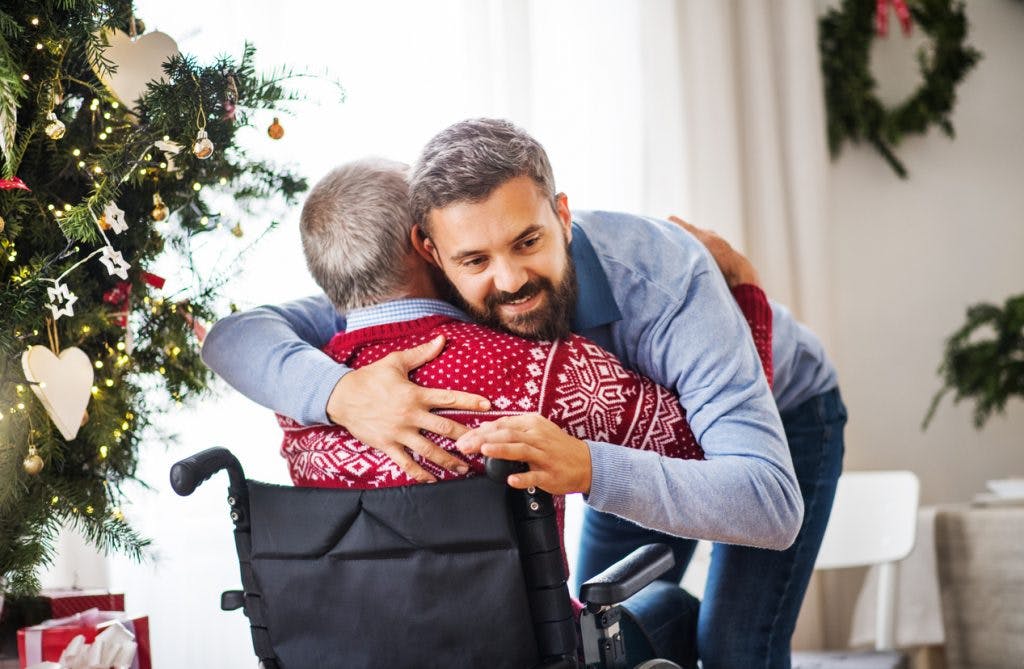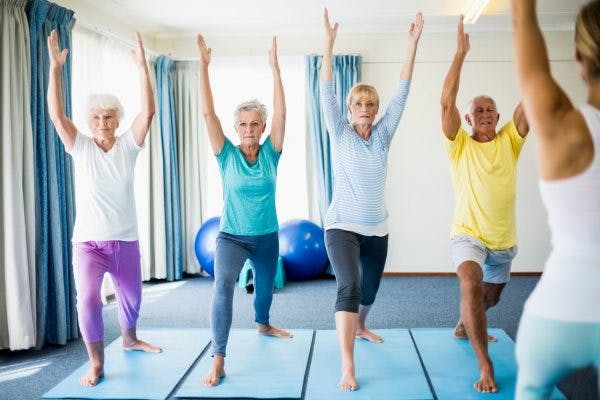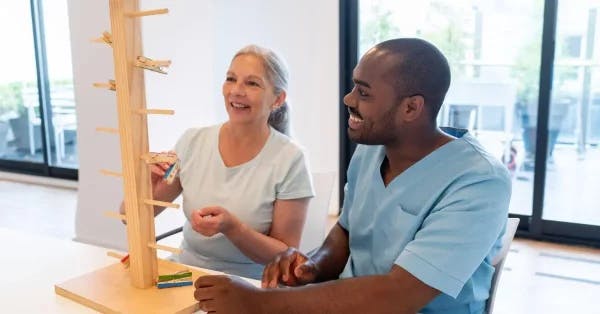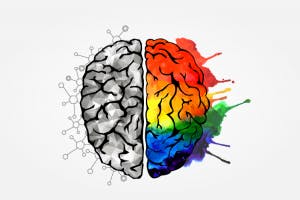Learning how to care for a stroke patient at home can be a challenging yet rewarding experience. Following a stroke, survivors may have a wide range of abilities and limitations. Therefore, the level of care that family members and caregivers may have to provide can vary widely.
However, the basics of how to care for a stroke patient at home remain the same: assist the survivor with daily tasks as needed, provide emotional support, and take steps to help promote recovery. It’s also important for family members and other caregivers to take preventative measures to avoid the medical complications that survivors may experience.
This article will outline a ten of the best tips regarding how to care for a stroke patient at home. Feel free to use the links below to jump directly to any section.
- Understanding the effects of stroke
- Preparing to care for a stroke survivor
- How to care for a survivor at home
- Promoting recovery
Understanding the Effects of a Stroke
Before addressing how to care for a stroke patient at home, it is essential to understand the potential effects stroke survivors may experience. A stroke occurs when the blood supply to or within the brain becomes compromised. This results in a lack of oxygen and essential nutrients being delivered, causing affected areas of the brain to become damaged.
Depending on the areas of the brain that sustain damage, survivors may experience a number of physical, cognitive, emotional, and behavioral changes. These effects can vary in severity, with some survivors experiencing very mild effects, while others may have significant limitations requiring around the clock care.
Following hospitalization and a potential stay in a rehabilitation facility, many stroke survivors return home. While the survivor’s abilities may have improved, many still have functional limitations. With this in mind, it is essential for family members and other caregivers to have an understanding of how to care for a stroke patient at home in order to best support their loved one.
Preparing to Care for a Stroke Survivor at Home
Even before a stroke survivor returns home, family members can take a number of steps to prepare for their arrival and care. Discussing practical considerations and concerns with medical professionals, as well as making changes to the home environment, can help to ease the transition home.
The following list outlines some of the best ways to prepare for a stroke survivor returning home:
1. Consult with rehabilitation professionals
While doctors and nurses are essential components of a survivor’s medical team, their physical, occupational, and speech therapists have an excellent understanding of the survivor’s abilities and limitations. Occupational therapists in particular specialize in assessing one’s ability to participate in daily activities.
Therefore, occupational therapists may have great insight into what types of assistance a survivor may need upon returning home. They can also advise family members on which types of adaptive equipment could be helpful.
2. Meet with social workers or case managers
Social workers and case managers are also an essential part of the stroke recovery team. They can provide survivors and family members with critical information on topics such as insurance coverage after discharge, how to set up home health or outpatient rehabilitation, and where and how to obtain necessary medical equipment.
3. Consider making home modifications
Stroke survivors are often at a high risk of falling due to hemiplegia (weakness on one side of the body), balance problems, or one-sided neglect. Making home modifications can improve the survivor’s ability to navigate the home safely upon their arrival.
Common home modifications include installing grab bars and non-slip mats, decreasing clutter, and removing floor mats and cords from walkways. An occupational therapist can be a great resource to discuss which home modifications may be most appropriate.
4. Do a “practice run”
While there is no way to truly understand how to care for a stroke patient at home before experiencing it firsthand, many family members find practicing being a caregiver in a safe environment can be very helpful. This practice may be in the form of a caregiver training session with an occupational therapist, during which the primary home caregiver practices assisting with basic daily activities, such as dressing, bathing, and showering.
Alternatively, some rehabilitation facilities have the option of performing a home visit. This involves the survivor and a therapist traveling to the survivor’s home to ensure the environment is set up for their success. This can also be a great opportunity for family members and caregivers to discuss any concerns regarding the survivor’s return home.
Many stroke survivors are excited to return home, but may be anxious about the transition. However, by adequately preparing, family members and caregivers can relieve most concerns and help to make the transition easier on all involved.
How to Care for a Stroke Survivor at Home
Since each stroke is different, the needs of each survivor upon returning home will vary. There are some tips, however, that can be applied to almost any survivor’s situation. This includes family members and caregivers providing an appropriate amount of assistance, focusing on compensatory techniques, and preventing any further complications.
5. Doing with, not doing for
Even upon returning home, stroke survivors are continuing to recover affected functions. In order to promote recovery, it is essential that family members and caregivers allow survivors to do as much as they are capable of doing.
If a survivor struggling with a task, caregivers should not jump in and complete the whole task for them. Rather, they should complete the activity together, encouraging the survivor to push themselves to do as much as possible. Practicing challenging tasks, especially on a daily basis, can help with recovery by stimulating neuroplasticity, or adaptive brain rewiring.
Additionally, encouraging survivors to take an active role in their daily activities can help them gain a more positive outlook on their recovery process. Caring for a survivor’s emotional needs is equally as important as caring for their physical needs. Thus, family members and caregivers should be as encouraging, uplifting, and motivating as possible, while keeping in mind that if a survivor’s emotional needs are significant, a medical consultation should be pursued.
6. Use practical compensatory techniques
There are a number of techniques that caregivers and stroke survivors may use to complete their activities of daily living. Some of the most common include:
- In first, out last. Dressing the affected side of one’s body first and undressing it last can help make dressing more manageable for survivors and caregivers alike.
- Utilize adaptive equipment as needed. Occupational therapists will often recommend various types of adaptive equipment to increase independence with daily activities. This can not only reduce caregiver burden, but also improve the survivor’s self-confidence and outlook.
- Lighthouse method. Encourage survivors with one-sided neglect or visual field cuts to turn their heads fully to each side to scan their surroundings, as the light of a lighthouse scans. Doing so can allow survivors to not only increase awareness of their environment, but also be more effective in completing daily tasks.
- Use reminder notes or pictures. For survivors experiencing cognitive challenges, family members and caregivers may find that using post-it note reminders or pictures of daily activities can help survivors be more independent. For example, a post-it note could be used on the bathroom mirror to remind the survivor to brush their hair and teeth.
These compensatory techniques, among others, can help reduce the burden of caregivers and increase the self-efficacy of stroke survivors for an improved experience for all involved. Further compensatory techniques to improve independence can be discovered with an occupational therapist.
7. Preventative care
Preventative care is another very important component of caring for a stroke patient at home. In addition to caring for the survivor’s everyday needs, family members and caregivers should:
- Ensure medications are being managed and administered appropriately, and always consult with a doctor before adding or changing any medications
- Monitor the survivor for any changes in their status, which may indicate a late-onset stroke effect or an adverse side effect of medication
- Take measures to prevent falls, and seek medical attention if a fall does occur
- Promote healthy lifestyle changes, such as an improved diet and regular exercise, to reduce the risk of another stroke
Individuals caring for a stroke survivor at home should consistently keep safety concerns in mind. Family members and caregivers should ensure all medical documents are organized in a specific location and be proactive in order to minimize the risk of complications.
8. Caregiver self-care
In addition to discovering how to care for a stroke patient at home, family members and caregivers also have to learn how to integrate caring for themselves into their routines. This is an important part of avoiding or preventing caregiver burnout.
It is impossible to constantly be pouring from an empty cup; therefore, caregivers have to ensure they are consistently finding ways to “refill”. Ways to recharge can include:
- Making time for self-care activities, such as taking a walk or doing yoga
- Joining a caregiver support group
- Utilizing meditation, breathing exercises, or relaxation techniques to destress
In addition to caring for personal emotional needs, caregivers of survivors with more intensive physical needs must also learn how to use their bodies effectively to avoid getting injured. One of the best ways to do this is by using proper body mechanics.
When helping with transfers and other heavy lifting tasks, caregivers should start by using a wide base of support, with their feet placed at the hips’ width apart. To lift, bend at the knees rather than the waist and avoid twisting at the back or waist. Using these techniques can allow caregivers to limit their risk of injury while assisting their loved one.
In addition to family members and caregivers caring for the stroke patient at home, many stroke survivors continue to pursue recovery through home health or outpatient rehabilitation services. While formal rehabilitation services are excellent ways to promote recovery, oftentimes the most important steps toward recovery are made by continuing to practice at home.
How to Promote Recovery at Home
Family members and caregivers can play an essential role in motivating survivors to pursue recovery after stroke. Since a stroke involves damage to the brain, the best way to improve after a stroke is to repair this damage. This involves the process of neuroplasticity, or adaptive brain rewiring, which allows healthy areas of the brain to assume control of affected functions.
Neuroplasticity is activated through massed practice, or consistently and repetitively practicing exercises and activities that involve affected functions. When family members and caregivers encourage survivors to continue practicing the skills learned in therapy at home, it stimulates changes within the brain, promoting recovery.
Family members and caregivers should keep the following advice in mind when promoting recovery at home:
9. Encourage daily rehabilitative exercise
Regularly practicing exercises and activities that involve use of one’s affected functions is essential for recovery. Many therapists provide survivors and caregivers with a home program that includes exercises tailored to the survivor’s needs. While this is an excellent place to start, any challenging but doable task can help promote neuroplasticity and boost recovery.
10. Recovery is always possible
Most stroke survivors experience a plateau after the first 3 months of recovery. However, this is not a sign that the survivor is done recovering. Neurological changes stabilize after several months, but functional improvements are possible for a lifetime. The brain is capable of changing and healing even decades after stroke.
Therefore, even if progress seems to be slowing down, the recovery process is not yet over. The road to recovery is not linear, and many survivors experience ups and downs along the way. However, if individuals continue to pursue recovery, the potential for improvement is always there.
Want 20 pages of stroke recovery tips in an illustrated PDF? Download our free ebook by clicking here (link opens a pop up for uninterrupted reading)
Understanding How to Care for a Stroke Patient at Home
It is hard to fully understand how to care for a stroke patient at home before doing so. Family members and caregivers who proactively prepare for their loved one’s arrival home tend to experience a smoother transition.
When a survivor arrives home, caregivers must learn how to best support the survivor’s needs, while not stunting their recovery by doing too much. It is also essential for family members and caregivers to take preventative measures to ensure the survivor’s safety.
Family members and caregivers play a vital role in not only caring for an individual’s immediate needs, but also in encouraging recovery. Therefore, in order to best support their loved ones, it is important for caregivers to remember to also take care of themselves. Caring for a stroke patient at home can be a challenging task, but the end reward is well worth the work!










